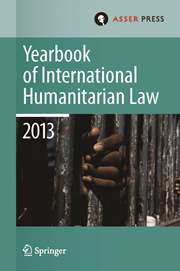Article contents
The Emblems of the 1949 Geneva Conventions: their Content and Meaning1
Published online by Cambridge University Press: 17 February 2009
Extract
From time immemorial, human beings have communicated using signs of one kind or another, among them gestures and graphic images. Knowledge of these different forms of communication gradually spread, and they became part of the common heritage of peoples and of humanity as a whole. The respect inspired by signs and symbols stems from the fact that they perform vital functions, such as channeling knowledge, helping survival and protecting individuals and their communities.
- Type
- Current Developments
- Information
- Copyright
- Copyright © T.M.C. Asser Instituut and the Authors 2000
References
3. Joly, L., Formes et signes: une géométrie originelle, (Geneva, Éditions Tricorne 1980) p. 5Google Scholar.
4. On this topic, see also the following well-documented studies by Bugnion, F., ‘The emblem of the red cross: A brief history’, 17 IRRC Nos. 193, 194, and 195 (1977)Google Scholar; and ‘Vers une solution globale de la question de l'emblème’, 82 IRRC No. 838 (2000) pp. 427 et seq.Google Scholar
5. Khaldun, I., Discours sur l'histoire universelle, Collection “Thesaurus” (Aries, Éditions Sindbad, Actes Sud 1997) p. 423Google Scholar.
6. de Coulanges, N.-D. Fustel, La cité antique (Paris, Flammarion 1984) p. 242Google Scholar.
7. Ibid.
8. Ibid., pp. 242–243.
9. I. Khaldun, op. cit. n. 5, at p. 427.
10. Aouli, S. et al. , Abel el-Kader (Paris, Éditions Fayard 1994) p. 331Google Scholar.
11. El-Djazaïri, A.D., La voie du Musulman, Vol. 2 (Paris, ASLIM Éditions 1986) p. 374Google Scholar; note that Abu Bakr's password has been incorrectly translated as ‘Kill! Kill!’.
12. See Guillermand, J., ‘La vision de la guerre de Crimée du médecin inspecteur Lucien Baudens’, in Durand, R. and Meurant, J., eds., Préludes et pionniers, les précurseurs de la Croix-Rouge 1840–1860 (Geneva, Société Henry-Dunant 1991) p. 170Google Scholar.
13. Pictet, J., Le signe de la croix rouge (Geneva, ICRC 1949) p. 5Google Scholar.
14. See Pictet, ibid.
15. Pictet, ibid., and Bugnion, op. cit. n. 4 (‘Vers une solution globale…), p. 432.
16. Pictet, ibid.
17. Bugnion, (Vers une solution globale…') op. cit. n. 4, and Pictet, op. cit. n. 13, at p. 6.
18. Pictet, op. cit. n. 13, at p. 7.
19. Pictet, op. cit. n. 13.
20. Markus, S., Henry Dunant, apôtre de la Croix-Rouge (Paris, Les Deux Sirènes 1948) p. 89Google Scholar.
21. The pressures exerted by Henry Dunant on the delegates from states, and in particular Dr Basting (Netherlands), are related in detail by Markus, ibid., pp. 88 et seq.
22. See also the analysis and references by Bugnion (‘Vers une solution globale…’), op. cit. n. 4, at p. 433.
23. See Pictet, op. cit. n. 13, at p. 6; Bugnion, (‘Vers une solution globale…’), op. cit. n. 4, at p. 434; Huber, M., La pensée et l'action de la Croix-Rouge (Geneva, ICRC 1954) pp. 108 et seq.Google Scholar
24. Moynier, G. and Ador, G., ‘Les destinées de la Convention de Genève pendant la guerre de Serbie’, 7 Bulletin international des sociétés de secours (10 1876) pp. 165 et seq.Google Scholar, and January 1877, p. 36.
25. Art. 19.
26. See Bugnion (‘Vers une solution globale…’), op. cit. n. 4, at p. 441.
27. Final record of the Diplomatic Conference of Geneva of 1949 (hereinafter: Final record), Federal Political Department, Berne, n.d., Vol. II A, p. 91.
28. Chevalier, J. and Gheerbrant, A., Dictionnaire des symboles (Paris, Robert Laffont 1982) p. 319Google Scholar.
29. The Koran, translated with notes by Dawood, N.J. (London, Penguin 1990) p. 374Google Scholar.
30. Ibid.
31. Ibid.
32. Tadjadod, M., ‘Le zoroastrisme et le culte du feu’, Le courrier del' UNESCO (01 1995) p. 23Google Scholar.
33. For further details see Bugnion, (‘Vers une solution globale…’), op. cit. n. 4, at p. 442, and pp. 453 et seq., and Rosenne, S., ‘The red cross, red crescent, red lion and sun and the red shield of David’, 5 Israel YB (1975)Google Scholar.
34. Final record, op. cit. n. 27, Vol. II B, p. 225.
35. Ibid.
36. Ibid.
37. It should be remembered that the draft Israeli amendment had been rejected at a vote taken by the Conference's First Committee, by 21 votes to 10, with 8 abstentions; 19 delegations were absent: on this see Final record, op. cit. n. 27, Vol. II A, pp. 90–92 and 150–151, and Vol. II B, p. 225; see also Bugnion (‘Vers une solution globale…’), op. cit. n. 4, pp. 438 et seq.
38. Final record, op. cit. n. 27, Vol. 1, p. 348.
39. The Jewish Student Online Research Center (JSOURCE), http://www.us-israel.org/jsource/Judaism/star.html.
40. See Ouaknin, M.-A. et al. , Les grandes religions, (Paris, Éditions Assouline 1998) p. 177Google Scholar.
41. Kazakhstan recently indicated that it wished to use only the distinctive sign of the red cross.
42. See Sommaruga, C., ‘Unity and plurality of the emblems’, 32 IRRC, No. 289 (1992) pp. 333–338CrossRefGoogle Scholar, and Bugnion, (‘Vers une solution globale…’), op. cit. n. 4, at pp. 456 et seq.
43. These states were: China, Colombia, Egypt, France, India, Iran, Israel, Kazakhstan, Lebanon, Malaysia, Russian Federation, Senegal, Switzerland, United Kingdom, and United States.
44. Working paper proposed by Ms Christina Magnuson, member of the Standing Commission of the Red Cross and Red Crescent, Geneva, October 1998.
45. These consultations were conducted by the representatives of Switzerland, the ICRC, and the International Federation in the following countries: Burkina Faso, China, Egypt, Eritrea, Germany, Israel, the Occupied Territories and the Autonomous Territories, Japan, Kazakhstan, Lebanon, Russian Federation, Syria, Togo, United Kingdom and the United States.
- 3
- Cited by


